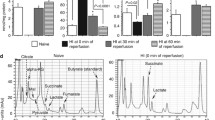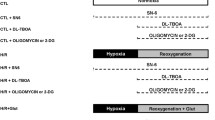Abstract
Acute or chronic brain ischemia induces a cascade of pathobiochemical reactions that finally result in the development of focal neurological deficit, dyscirculatory encephalopathy, or the death of a patient. We studied the effects of ischemia at different time points, including 1, 6, 24, 48, 72, and 120 h, and 21 days. During the period of the strongest ischemia-induced disturbances (24–72 h), we found lactate over-production associated with inhibition of hexokinase, an enzyme that catalyzes the first “trigger” reaction of glycolysis. An increase in the malate content associated with increasing activities of mitochondrial and cytosolic malate dehydrogenases within the first hours of cerebral ischemia indicates the activation of the malateaspartate shuttle, which is responsible for the transportation of reduced equivalents to mitochondria. The inhibition of malate production and activity of NAD-dependent malate dehydrogenase correlates with a decrease in the contents of ATP, HSP70, and hypoxia-induced factor-1a (HIF-1a) and the severity of neurological disturbances. We believe that in response to brain ischemia, HIF-1a is expressed, which induces compensatory mechanisms of energy production.
Similar content being viewed by others
References
Iadecola, C., Cerebral ischemia, New Jersey: Humana Press, 1999, pp. 3–33.
Zozulya, I.S. and Bobrova, V.V., Ukr. Nevrologichnii Zhurn., 2006, no. 1, pp. 5–8.
Rumyantseva, S.A., Afanas’ev, V.V., and Silina, E.V., Zhurn. Nevrol. Psikhiatrii im. S.S. Korsakova, 2009, no. 3, pp. 64–68.
Brann, D.W., Dhandapani, K., Wakade, C., Mahesh, V.B., and Khan, M.M., Steroids, 2007, vol. 72, pp. 381–405.
Sudakov, N.P., Nikiforov, S.B., Konstantinov, Yu.M., and Yakubov, L.A., Byulletin VSNTs RAMN, 2006, no. 5, pp. 332–336.
Vinogradov, V.M. Pharmacological tools for prevention and treatment of hypoxia (state of the problem), in Kislorodnyi gomeostazis i kislorodnaya nedostatochnost’ (Oxygen Homeostasis and Hypoxia), Kiev: Naukova Dumka, 1978, pp. 183–192.
Belenichev, I.F., Bashkin, I.N., and Vizir, V.A., Structural-functional and biochemical changes in the brain tissue under conditions of cerebral hypoxia, in Kompensatorno-prisposobitel’nye mekhanizmy vnutrennikh organov i golovnogo mozga v norme, patologii i eksperimente (Compensatory and Adaptive Mechanisms of Autonomic Organs and the Brain under Norm, Pathology, and Experiment), Tyumen’, 1991, pp. 104–110.
Belenichev, I.F., Bashkin, I.N., Vizir, V.A., and Dunaev, V.V., Contingency of changes in metabolisms of the brain and myocardium under experimental cerebral hypoxia, in Korrektsiya serdechno-sosudistykh narushenii v klinike i eksperimente (Correction of Cardio-Vascular Disorders in Clinical Practice and Experiment), Vinnitsa, 1991, pp. 7–10.
Giordano, F.J., J. Clin. Invest., 2005, vol. 115, pp. 500–508.
Mazur, I.A., Chekman, I.S., and Belenichev, I.F., Metabolitotropnye preparaty (Metabolic Drugs), Zaporozhye, 2007.
Huss, J.D., J. Clin. Invest., 2005, vol. 115, pp. 547–555.
Galenko-Yaroshevskii, P.A., Chekman, I.S., and Gorchakova, N.A., Ocherki farmakologii sredstv metabolicheskoi terapii (Essays on Pharmacology of the Drugs for Metabolic Therapy), Moscow: Meditsina, 2001.
Tishkin, V.S., Clinical and Experimental Study on Efficacy of the Drugs for Metabolic Correction in Combined Therapy of Acute Myocardium Infarct, Doctoral (Medicine) Disseratation, Zaporozhye, 1989.
Mokrushin, A.A., Pavlinova, L.I., Guzhova, I.V., and Margulis, B.A., Dokl. Akad. Nauk, 2004, vol. 394, no. 3, pp. 419–422.
Katschinski, D.M., Le, L., Schindler, S.G., Thomas, T., Voss, A.K., and Wenger, R.H., Cell Physiol. Biochem., 2004, vol.14, pp. 351–360.
Dery, M.A., Michaud, M.D., and Richard, D.E., Int. J. Biochem. Cell Biol., 2005, vol. 37, pp. 535–540.
Nowak, T.S.Jr., Osborne, O.C., and Suga, S., Prog. Brain Res., 1993, vol. 96, pp. 195–208.
Papadopoulos, M.C., Sun, X.Y., Cao, J., Mivechi, N.F., and Giffard, R.G., Neuroreport., 1996, vol. 7, pp. 429–432.
Stefanov, O.V., Doklinichni doslidzhennya likarskikh zasobiv (metodichni rekomendatsii) (Preclinical Studies of Therapeutic Methods (Technical Guidelines), Kiev: Avitsenna, 2002.
Prokhorova, M.I., Sovremennye metody biokhimicheskikh issledovanii (lipidnyi i energeticheskii obmen) (Modern Methods of Biochemical Studies (Lipid and Energy Metabolism), Leningrad: Izd. Leningradskogo Univ., 1982.
Avrames, S. and Termynck, T., Mol. Immunol., 1993, vol. 30, pp. 119–127.
Beere, H.M., J. Cell Science., 2004, vol. 117, pp. 2641–2651.
McGrow, C.P., Arch. Neurol., 1977, vol. 34, no. 6, pp. 334–336.
Lapach, S.N., Chubenko, A.V., and Babich, P.N., Statisticheskie metody v medico-biologicheskikh issledovaniyakh s ispol’zovaniem EXCEL (Statistical Methods in Medical and Biological Studies Using EXCEL), Kiev: MORION, 2002.
Huang, L.E., Gu, J., Schau, M., and Bunn, H.F., Proc. Natl. Acad. Sci. USA, 1998, vol. 95, pp. 79–96.
Author information
Authors and Affiliations
Corresponding author
Additional information
Original Russian Text © I.F. Belenichev, Yu.M. Kolesnik, S.V. Pavlov, E.P. Sokolik, N.V. Bukhtiyarova, 2012, published in Neirokhimiya, 2012, Vol. 29, No. 1, pp. 28–34.
Rights and permissions
About this article
Cite this article
Belenichev, I.F., Kolesnik, Y.M., Pavlov, S.V. et al. Malate-aspartate shunt in neuronal adaptation to ischemic conditions: Molecular-biochemical mechanisms of activation and regulation. Neurochem. J. 6, 22–28 (2012). https://doi.org/10.1134/S1819712412010023
Received:
Published:
Issue Date:
DOI: https://doi.org/10.1134/S1819712412010023




